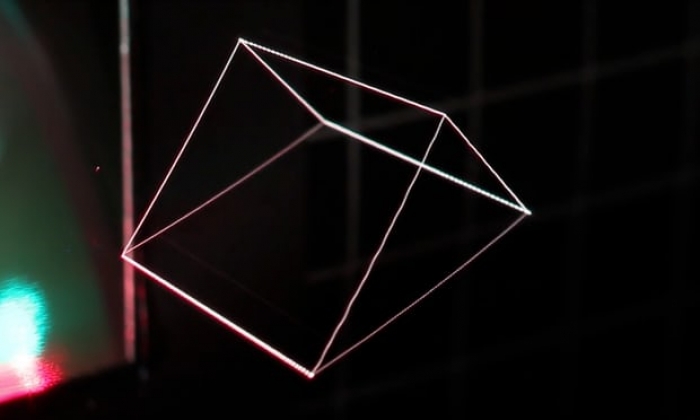A new paper in the journal Nature reports a breakthrough from a group of researchers at Brigham Young University in Utah: the first creation of a “free-space volumetric display”, capable of reproducing full-colour graphics floating in the air, visible from all angles.
The technology, dubbed the “optical trap display”, works using a technique that sounds like it was ripped from the cinema screen. “You capture a particle in an invisible, or almost invisible ‘tractor beam’,” explains the lead researcher, Daniel Smalley, “then you drag that around to every point of an image. When it’s in the right place, you shoot it with red, green and blue lasers to make it illuminate, and build up an image point by point, dragging this cellulose particle around as you go.”
The technology isn’t quite ready for primetime yet, however: at current speeds, the images are either very small, or very slow to create. A very simple spiral is visible with the naked eye, but only just: it’s a couple of millimetres high. A much more detailed image, of a researcher posing in the style of Princess Leia from Star Wars, could only be photographed with a long exposure. It took 40 seconds for the particle to fully trace out the image.
But those problems could be ironed out, Smalley says. Introducing more particles to any given display, so that at any time 10 or 100 dots are tracing out the image, would be one option; another would be to continually reintroduce new particles when old ones get lost. “After all, these are as cheap as, literally, dirt.”

A long-exposure image created with the OTD technology. Photograph: Nature mag / nature.com
And it would be worth iterating on: the technique gives the display properties that other 3D displays can’t possibly achieve, Smaller says. “The breakthrough here, I think, is to create a 3D display platform that is capable of creating the images of science fiction.” Other display technologies have inherent downsides: stereoscopic and holographic displays, for instance, can only display objects in a line of sight between the “screen” and the viewer – move too far to the side, and they disappear.
Another type of display, called a volumetric display, typically works by rapidly rotating or moving a transparent surface, building up a 3D image that can be viewed from all angles – but cannot be interacted with, since inserting an object (like a finger) into the display interferes with the movement of the surface on which the image is formed.

A simple wireframe image created using the optical trap display technology. Photograph: Nature mag / nature.com
Smalley specifically cites a few films as responsible for creating the belief that those limited technologies don’t go far enough: the Princess Leia projection from Star Wars, and the computers shown in the films Avatar and Iron Man. “I think I’ve bought into what, I believe, is this collective vision of the future,” Smalley says. “Every time a new display comes out, the line is always ‘Princess Leia display around the corner’, that sort of thing. More often than not, unfortunately, you find out that that technology is fundamentally impossible.”
Iron Man, released more than a decade ago, was a specific touchpoint for the research. “There was an epiphanic experience that happened, at the beginning of all of this. I was in the Iron Man movie, and there’s a scene where the protagonist, Tony Stark, sticks his arm inside an ostensibly holographic gauntlet. And when I saw that, before seeing that scene, I had believed that holography could do anything. But when I saw that, I realised it couldn’t, because as he sticks his hand over the lit-up table, now he’s blocking the light. So how then is that appearing above his hand?
“When I saw that film, I thought the only way you could make that display was with something like floating nanobots shooting lasers. And it’s interesting, now, that we’ve happened upon a way that’s not dissimilar to that idea.”
The Guardian
More about: science
















































